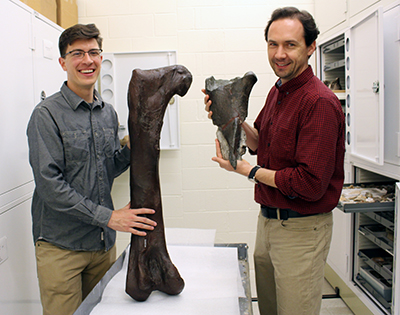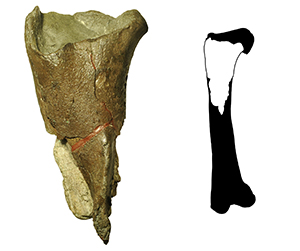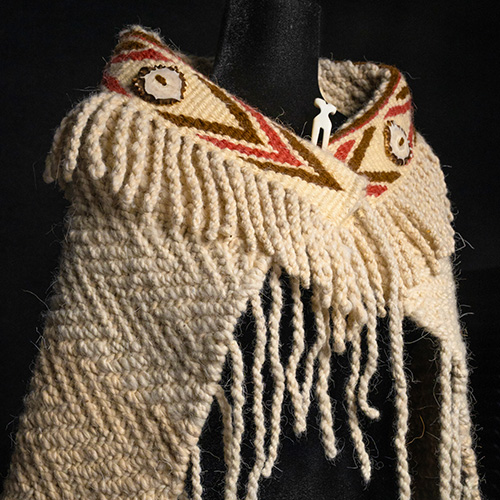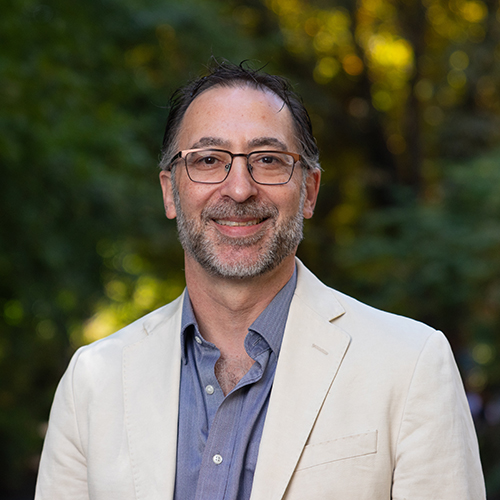It doesn’t look like much. The fossilized bone, about 16 inches long, resembles a fragment of craggy rock. But Burke Museum researchers who spotted it while collecting ammonite fossils on Sucia Island in Washington’s San Juan Islands knew it was something more.
That “something” turned out to be a dinosaur bone—the first found in Washington state. The bone is now on display at the Burke Museum.
Figuring out what bone it was, from what species of dinosaur, took a bit of sleuthing. But first the fossil had to be excavated and transported to the Burke’s vertebrate paleontology lab. “Sucia Island is marine rock, so we were expecting some sort of marine animal,” recalls biology graduate student Brandon Peecook, part of the five-person team that dug up the fossil. “But it only took about twenty minutes with the bone to realize this was something else. It seemed to be a hollow bone, and hollow bones don’t occur in marine animals, so even then we thought it might be a dinosaur. It was definitely not what we were expecting.”

Peecook remembers being “extremely excited” on the beach at Sucia Island, but mostly focused on excavating the fossil before the tide came in. When the team brought the fossil to the Burke for study, Christian Sidor, professor of biology and the Burke’s curator of vertebrate paleontology, was less enthralled. “I was very pessimistic,” he recalls with a laugh. “I knew it was a dinosaur, but until we knew what bone of the skeleton it was and what type of dinosaur it was, it wasn’t going to be worth too much effort. It’s not compelling to say ‘It’s a bone, but I don’t know which bone, and it’s from a dinosaur, but I don’t know which dinosaur.'"
Like other biologists, we study animals. These animals just happen to be extinct.
What finally convinced Sidor that they might be able to learn more was a ridge along one side of the bone. That distinctive feature was critical when Peecook compared the bone to specimens in Montana’s Museum of the Rockies and then the Royal Tyrrell Museum of Palaeontology in Alberta, Canada, which he visited with Sidor thanks to research funds from the Burke. “That museum has one of the most extensive dinosaur collections in the world,” says Sidor. “We brought a cast of the bone up there and spent two full days doing side-by-side comparisons.”
The pair eventually identified the bone as part of the femur from the leg of a theropod dinosaur, dating back to the Late Cretaceous, about 80 million years ago. Theropods are a group of two-legged, carnivorous dinosaurs that includes Velociraptor, Tyrannosaurus rex, and modern birds. For those who question how such an identification could be made from just part of a bone, Peecook says it’s amazing what you can glean from certain fossils. “A new dinosaur was named today based on just the ankle and part of the foot,” he says. “If you looked at it from a distance, you might say, ‘Based on just that? How do you know?’ But paleontologists have so many accumulated years of observation and detailing of anatomy that they are able to name new species based on that. Already this year, twenty new dinosaurs have been named. It’s a very hot and ongoing science.”

It’s also a science that has fascinated Peecook since childhood. “As a kid, I loved extinct animals and I loved living animals,” he says. “In middle school, when I started reading about evolution and getting it a little bit, I realized that the dinosaurs and the trilobites are exactly the same story as the deer and cardinals in my yard. It’s all the same thing.”
That perspective has gained traction over the past two decades. Sidor says that paleontology, once housed in geology departments, now has a strong presence in biology departments. Through technological advancements — CT scanning to understand brain sizes, histology to understand bone growth, computer-based methods to create family trees — extinct animals can be studied much like living species. “Fossils found in layers of rock once served as markers to figure out how old the rocks are,” says Sidor. “These days in paleobiology, we think of them much more like living organisms. Like other biologists, we study animals. These animals just happen to be extinct.”

Of course some questions are more difficult to answer because of extinction. How, for example, did a dinosaur’s femur bone from the Late Cretaceous end up in Washington state, which was mostly underwater at the time? Such a find is so rare that similar fossils have been found in only ten places west of the Rockies, from Mexico to Alaska. A likely scenario is that the rocks that today form Sucia Island were deposited elsewhere and moved due to plate tectonics and other geologic forces.
No one knows the whole story except the dinosaur, whose femur will remain on display in the Burke Museum lobby indefinitely. “The fossil won’t win a beauty contest, but it gives us insight into what the West Coast was like 80 million years ago,” says Sidor. “Plus,” adds Peecook, “it gets Washington into the Dinosaur Club.”
More Stories

The Public Impact of Private Cities
Geography major Edwin Bai has researched private cities, developed by individuals and corporations, that "take the libertarian idea of low government regulation to the maximum."

Coast Salish Traditions are "Woven in Wool" at the Burke
A Burke Museum exhibit, co-curated by Coast Salish weavers and Burke curators, highlights the importance of weaving to Coast Salish communities.

The Curious Journey of Chinese Characters
Several Asian countries adapted the Chinese writing system—the oldest writing system still in use—for their own languages. In a new book, Professor Zev Handel shares how that happened.